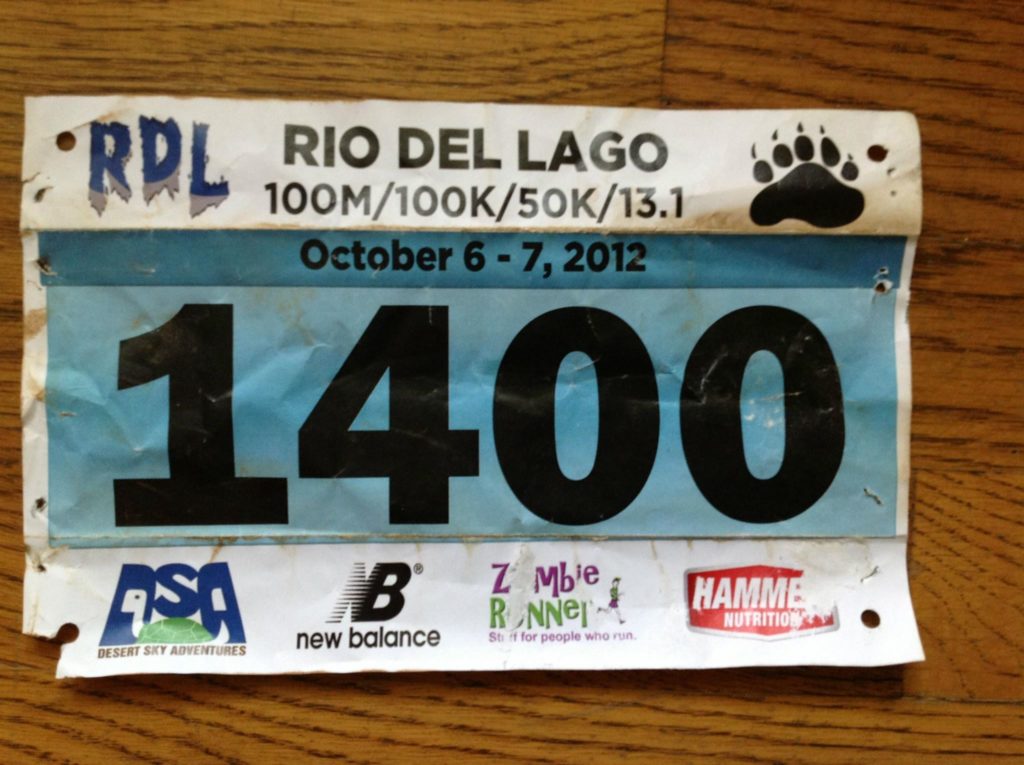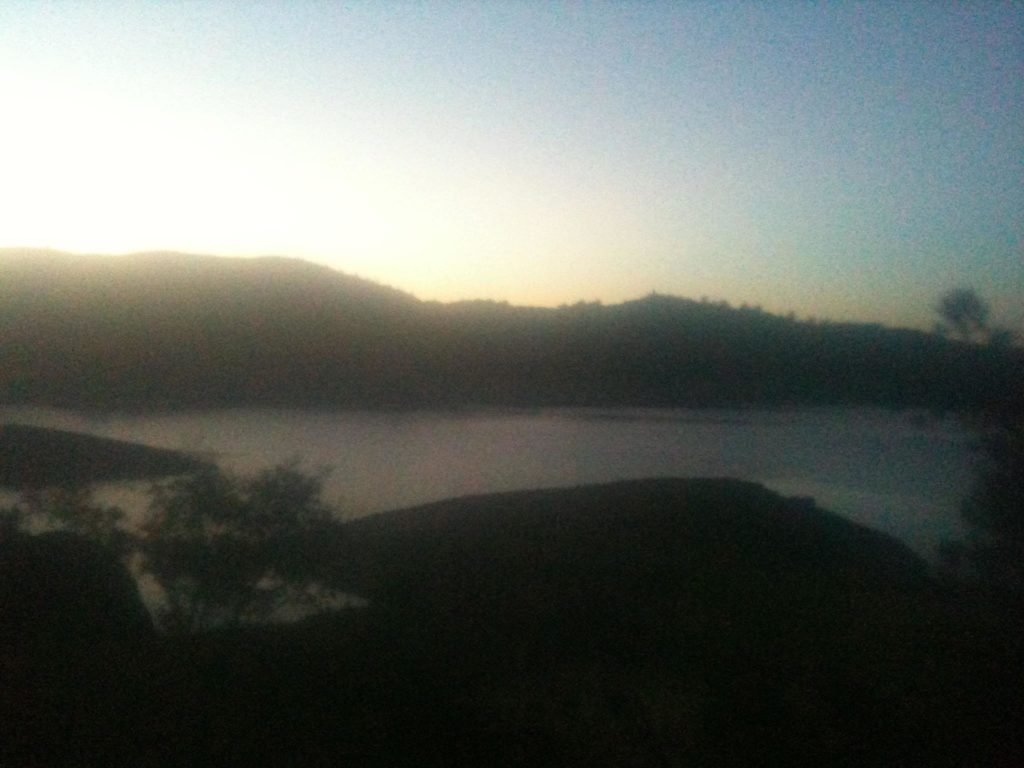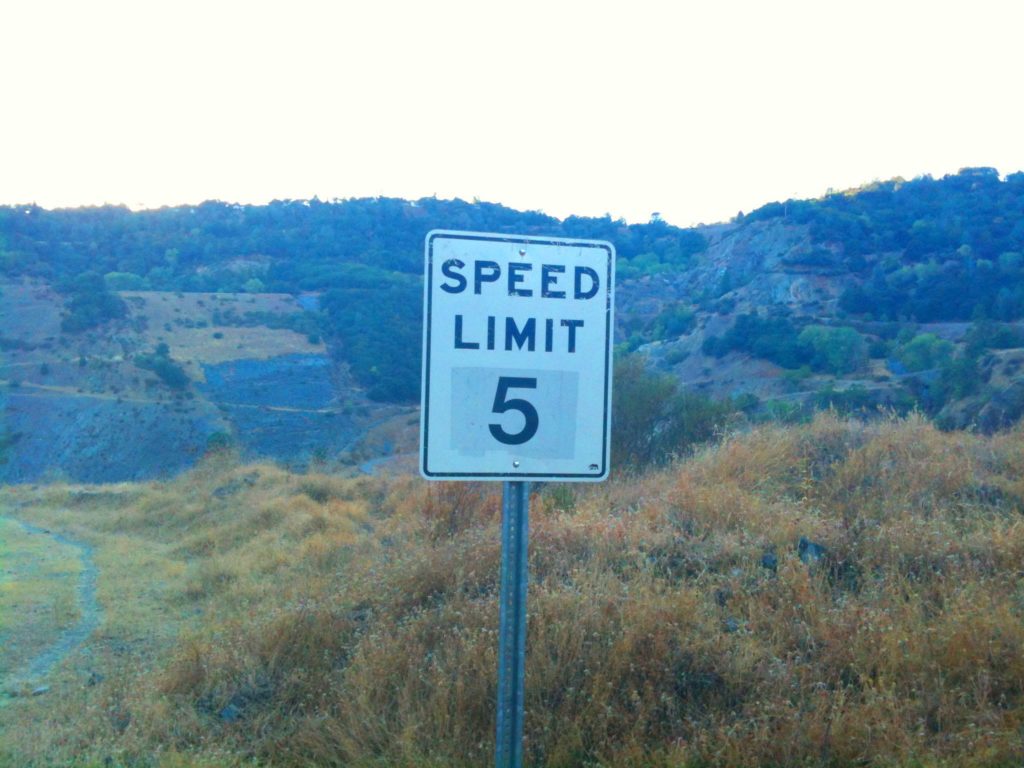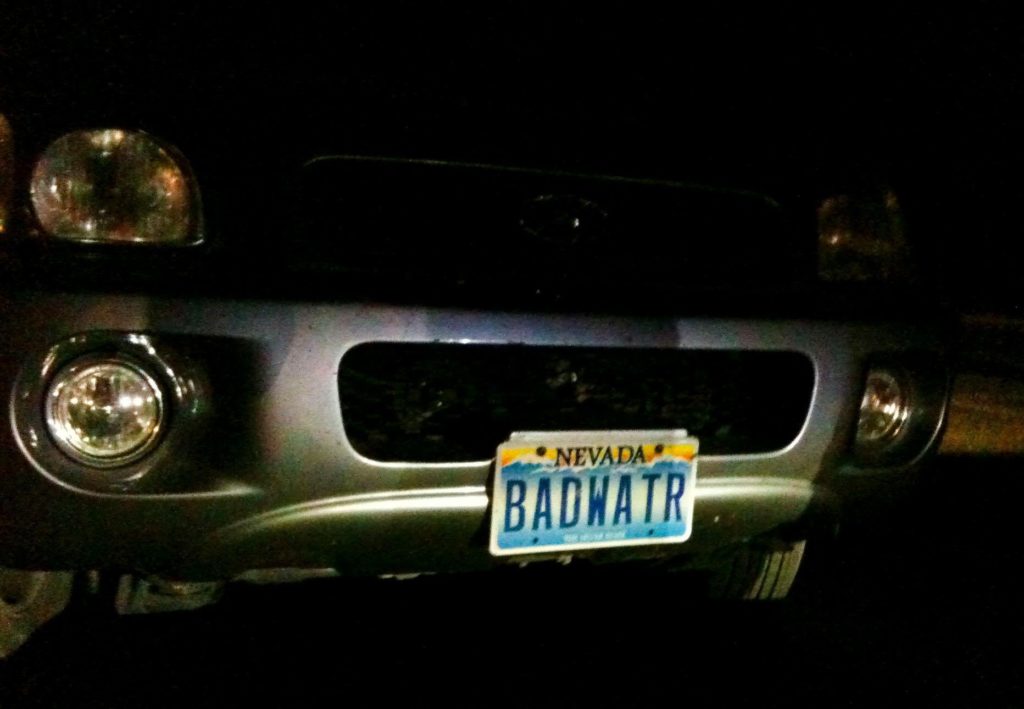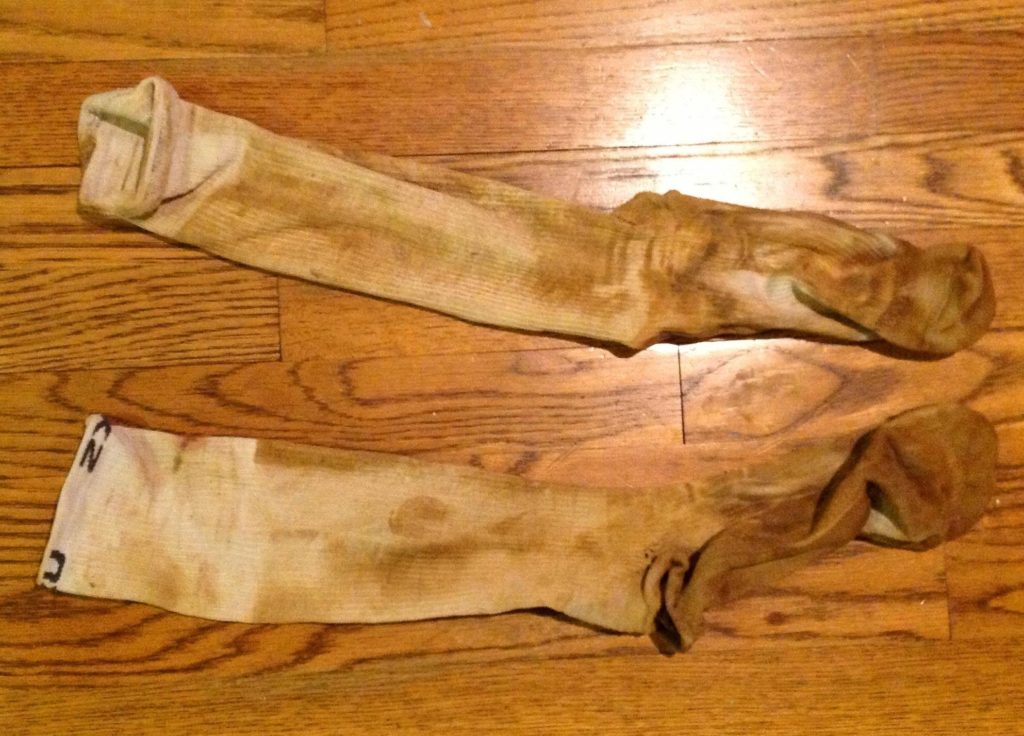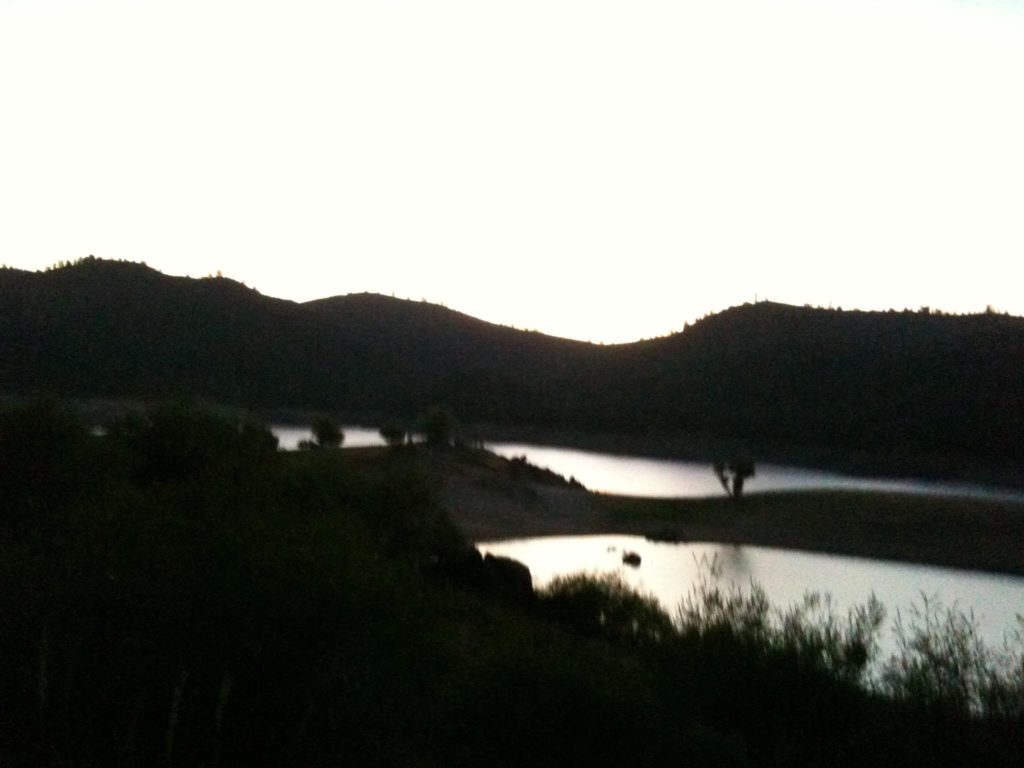
RIO DEL LAGO 100
After Miwok this year I was looking forward to running Pikes Peak Marathon but I was also looking for an opportunity to accumulate the points to qualify for the Ultra-Trail du Mont-Blanc (UTMB) in Chamonix, France, in 2013. I wanted to run the AC100 but it sold out very early and they don’t seem to want too many runners on the course since they don’t have a waiting list. It sold out for 2013 by the way… But here is the Rio Del Lago 100 Race report.
A friend told me that the Rio del Lago Hundred miler was a qualifier (I had to get 3 or more points before the end of the year and I would rather run in California). 2011 NFCE gave me 2 points, Miwok also two points (which seems abnormal but that is an issue that I will examine later) and a runner needs to accumulate 7 points in 3 races. Too afraid that it would sell out I registered right away. According to the web site, it looked like a very feasible 100 mi run with reasonable elevation gain (2700 m I think) and a generous cut-off time (34 hrs: what could go wrong? I could probably walk the whole thing and qualify for UTMB). The scenery looked nice and I heard that the course shares some trails with the WS100… legendary stuff, right?
THE COURSE
The 100 miles run goes north from Beal’s Point to where the American River joins Folsom Lake and then from Cool (what’s cool about Cool?) some loops are run 20 miles in one direction and 20 miles the other way around – then return home to Beal’s Point the way we came. 101 miles I think. The elevation gain is very easy (around 7500 feet I will have to confirm that – see chart below).

According to what I had heard there were not any real technical parts. The first (and last) 20 miles were supposed to be quite easy. Everyone was mentioning the climb around Cardiac. Nothing seemed very dramatic in terms of the course. Pictures of the scenery looked pretty with different types of the area visited, mostly Northern California forests and meadows. Aid stations looked like they were never spaced more than 6 miles apart.
HARD TO GET NAV DATA
The organizers provided a nice spreadsheet with mileage, aid station locations, cut-off times – I used it to make my own time estimates and splits, what would a reasonable goal be. Based on my Miwok pace of 14.4 min/mile I calculated I could finish RDL at 23:36. This made me feel rather confident. Especially that I had read that sub 24 runners would get a special belt buckle (no more medals)!

However, on the event web site, I couldn’t find anything that would resemble a map. This was making me a bit nervous. I tried to match the directions to trails on my topo maps but some locations like Fox Hollow, Coffer Dam, Cardiac, etc actually most aid station locations are not featured on the topo maps that I have. At the race meeting, they mentioned that angry folks living in the area were removing the marking ribbons. They don’t like runners they said. I know we were not running in a very dangerous zone and the likelihood of getting lost and/or in danger were slim but it’s a race, not a mountaineering trip. Army memories of being dropped in the dark in the middle of nowhere with the mission to come back to camp with no map! Fun and nerve-racking at once! Let’s go!
MAPS ARE IMPORTANT
The race organizers were kind enough to show me the maps they printed and I photographed them. Better too much info than not enough. I also downloaded the 7.5″ USGS maps of the area and the MotionX terrain maps – not many of the trails mentioned appeared on them! Hey, it’s an adventure race right! 34 hours to cover the ground and I can use the GPS on my phone – and I never get lost… just wait.
TRAINING
Oh, training… I’m so chaotic. All I do is run 4 days a week including a long run that I periodize – for RDL I was going to run 52 miles 3 weeks before the race but I was called to France and my mother passed away shortly after I got there. Instead, I ran 44 miles two weeks before the race and only ran 4 days a week thereafter with no long run at all. Some kind of crash taper. Again I’m sure some expert trainer could come up to me and tell me that I could improve my performance if I would be a little more serious about training but I really don’t care. What is performance anyway?
I don’t run for performance or more exactly I measure my performance with more indicators than just finish time. Of course, I’m still after my sub-3 marathon (PR is 03:07 now) and I’m happy when I have decent times (like a WS100 qualifier at Miwok). However what really matters to me is the enjoyment of the routine running and the happiness during and after the event, as well as remaining injury-free. So went the training: running happy and injury-free! I think swimming has a lot to do with remaining injury-free. The real struggle is to get the quality and quantity of sleep – I’m always on the verge of being sleep deprived – I stay up too late at night because… well there’s epic stuff happening on the Internet right?
GEAR
The second time I use my Salomon pack, I love it. See the contents in the picture. I had just bought an Arcteryx lightweight jacket that I really like. It wasn’t cheap but it packs tight and has awesome features. It kept me warm for the first two hours of the race. I highly recommend it.
Shoes: NB Minimus again. I like them. I am wondering if perhaps I shouldn’t purchase and use a more sturdy pair of shoes. They recommend Salomon Sense. I like the Minimus for the zero drops and agility they provide. I did hit my toes a couple of times but the pain didn’t last that long and I might not lose toenails as of the time of this writing. The Minimus are worn out now! I think I logged about 400 miles of trails by now, time for another pair.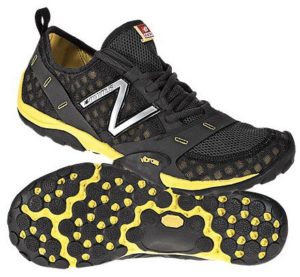
I wore a short-sleeve UnderArmor technical fabric tight shirt (no tank top – pack and arms would chafe). Pair of medium length shorts and compression socks. Hat with visor and cloth over the neck. Also carried a cool give away from RDL, some type of bandana to get wet to cool off. So outfit was pretty much the same as for Pikes Peak. Very comfortable in the moderate heat. I didn’t apply any body glide but I almost regretted it as my butt cheeks rubbed each other more than usual. Something to remember… I also heard the horror story of a support crew to had to pop the blister between the butt cheeks of his runner…
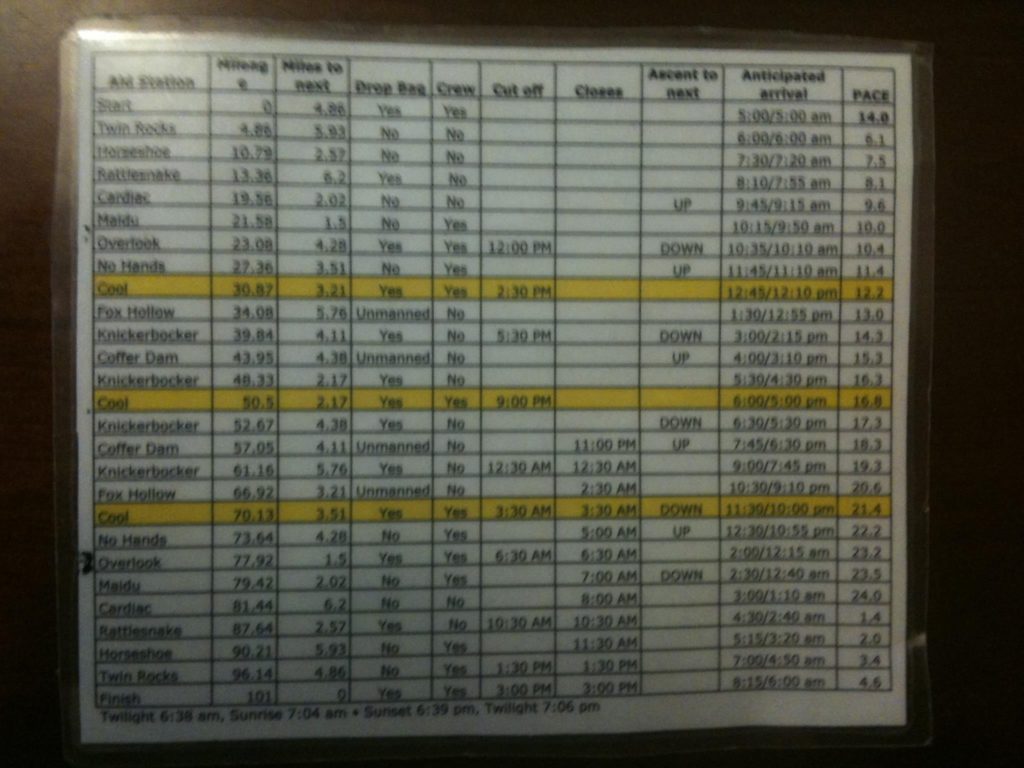
I decided to have only one drop bag that would be sent to Cool aid station (yes, there is a place called Cool. And there is a Cool Aid Station! I didn’t spend enough time there to judge the coolness of it. It wasn’t that hot). In the bag, there was extra clothing for the night and some food and care items (including a container of Traumeel homeopathic gel which I applied three times on my quads – I think this contributed well to very little soreness after the race.
NUTRITION
Because potatoes and pita/humus worked so well at Miwok I focused on getting some hummus and pita bread for this race (in my drop bag). I also packed some Stinger Honey gels (very good for a quick caffeine/electrolytes/calories shot as they go down easily and they are not processed like GU-style products). Some Japanese beam paste bars were also in all bags. I did pack some Bear Meal Packs and Bobo Oatmeal but I didn’t eat them, way too dry. The pouch in my bag was filled at 500ml at the start. I refilled with water and ice at the stations. Added Endurolytes as usual (about 2 to 4 capsules an hour – less at night when I wasn’t sweating any longer).
AID STATIONS FOOD
The aid stations were well stocked with great foods, Endulolytes, potatoes, pretzels, coke, ginger ale – at night, pizza, chicken soup. I ate from there as much as I could. Only took a Guayaki shot at 16:00 which gave me wings for about 6 hours (until I got lost at around 22:00). Ate my bean paste and maybe 4 honey gel packs. The rest I relied on the aid stations and it’s always a pleasure to interact with the awesome volunteers who take care of the stations.

I did great until midnight. I felt I was eating a lot, making a conscious effort to ingest calories. So I don’t know why at midnight I just puked out all the contents of my stomach. It just happened. Perhaps I was mixing too many things: grapes, bananas, coca-cola, sprites, and ginger ale. After that ingesting calorie was hard. Also perhaps my body isn’t used to digest stuff 24 hours a day, why should it be! For the last 20 miles or so I survived on coca-cola, chicken noodle soup, and some fruits. A runner I ran with for the last 13 miles gave me some ginger chews and that helped the stomach discomfort to go away.
THE EXPERIENCE
This was quite an adventure. I got to the race location driving from LA on Thursday as the start was at 5 am on Saturday. This gave me plenty of time to rest, get ready and eat a lot. There was a Wholefoods near my hotel and I filled up with pasta the night before the race. The day before the race I drove to the start area to avoid confusion the next day. I also went to get my bib number and attend the pre-race meeting where mostly they briefed us on how tricky it could be to navigate the course (see The Course above). I was in bed at 8:30 and slept quite well which is rare before an event (see Miwok). At 3 am it was time to get ready.
THE START
The start was well-staged near a beach of the Folsom Lake. There were maybe a couple of hundred participants (100K and 100M). 5 am – no song, no music, time to start running!

I started running with the pack. I was aware that I could easily get carried away so I just took a spot in the file and followed. It was fun. I like running with others and I like running alone. At first, we followed the lakeshore – Aid stops Twin Rocks, Horseshoe Bar, Rattlesnake Bar. There was a nice sunrise and navigating the course was easy not only because there was always another runner insight but also because course markers were visible. We got to Cardiac after that. The climbs weren’t very dramatic, a nice and relatively easy course. I felt great, it was one of those days when I could run forever (at least 34 hours!). The first 30 miles to Cool Fire Station were easy and I was about 45 minutes ahead of my schedule while I think I was still in the middle of the pack.
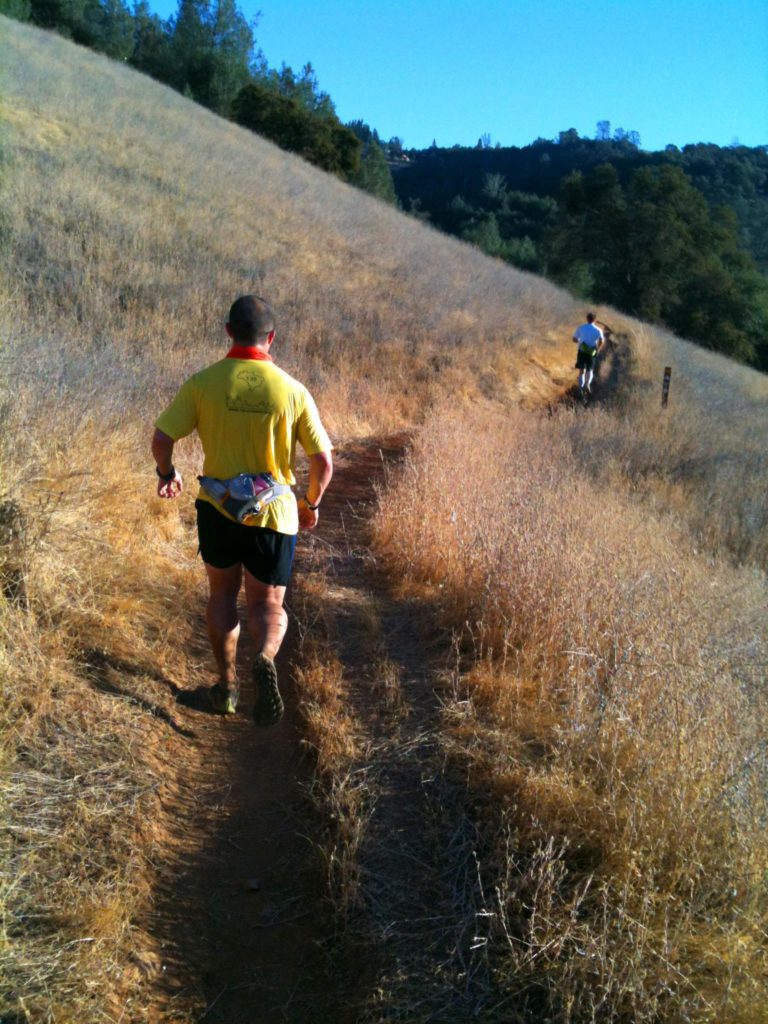
From Cool to Fox Hollow I started to pass runners and I settled with a bunch of guys still eventually going faster than them. It was pretty easy to navigate. Although markers weren’t extremely frequent they were enough, in daylight… The course consisted of rolling hills until Knickerbocker aid station. Then there was more elevation change to get to Coffer Dam.
MID WAY HEAT
It was the middle of the day and it was getting a little hot, low 80s maybe. My last long run (44 miles) featured a temp of 95F so I didn’t suffer from the heat but it did slow me down and got me a bit tired.
At mile 50 I took a Guayaki shot to perk up a bit and in combination with cooling temperatures it did give me some wings! It’s probably a good strategy to delay caffeine intake until midpoint I guess. Then, doing the 20 miles loop in reverse I started to pass more runners. I was still eating a lot (pizza!). I did get lost a bit on my way from Knickerbocker to Fox Hollow.
INTO THE NIGHT
Not all the markers had a reflecting coating and the red/orange ribbons aren’t very visible in the dark with a headlight.

I took a turn where I assumed was the right trail and got turned around and lost quite fast. Luckily I had my GPS and it was the second loop – I had marked places that aren’t on the map the first time there. Actually I placed a waypoint every time I stopped at an aid station. After Fox Hollow, the navigation back to Cool was a bit more relaxed because I could hear the road and there was a decent quantity of markers. By the time I got to mile 70, I was over an hour ahead of schedule!
GETTING LOST
I took a warmer jacket, ate more pizza and it was time to go home! 30 more miles! Running alone in the dark was fun as long as I would see a marker at reasonable intervals. I think they should either place no markers at all (this could be fun) or do it right. Of course, it was said that angry locals take out the markers. I’m not sure that’s a valid excuse when race organizers are somehow responsible for the safety of runners.
I arrived at No Hands Bridge pretty fast. I could see myself more clearly running sub 24! The lady at the aid station told me I was number 10. I thought it was a joke at first, but now she said I was among the top runners! This got me excited, not that I was racing but I felt I would do well. Then the trouble began. When I got to Robie Point there were three trails and no markers at all. I went down and back up each trail (there were actually some smaller trails I saw but didn’t take) maybe for a third of a mile. Nothing! I was getting upset and this was burning energy. I worked on not getting so upset, thinking that all I wanted was to finish and that I had plenty of time.
GETTING MORE LOST
Looking at my maps I opted for the cluster of houses and thought that perhaps I should take the road to go to Overlook (which was marked on my topo map but I couldn’t see very well what trail would lead there). So once on the road, I switched to Google maps. I ran past a house and I heard some people talking. I decided to take the risk to go toward them despite what I had heard about the locals. It turned out they were very nice and didn’t point a shotgun at me to force me to marry an inbred daughter while some kid played the banjo. Instead, they told me the first trail on the left was the right one. I had gone down that one but not far enough.
TOP RUNNER! ME?
From then on I became very suspicious of the markings and when I got to Overlook I totally vented out to the people there asking them to not take it personally (aid station people are awesome) and eventually apologizing for being so noisy. I think I was down to 30 minutes ahead of schedule.
But then on my way to Cardiac following the aqueduct I got lost again at the road since the marker there had been removed. I had Molly Sheridan’s (race director) number and there was cell phone reception so I called and she put me on the phone with Bill who helped me find the trail. Once at Cardiac a volunteer at the aid station was aware that I could have been lost and she ran back to place a marker. That was nice. Cardiac is when a runner named Joey would always get to the aid station 5 minutes after me.
LAST STRETCH
After Cardiac there was a long stretch (6.5mi) to Rattlesnake Bar and around midnight I got sick and puked out everything. Not surprising when I looked at what was in my stomach: grapes and coca-cola. It became really hard to eat from then on and I relied mostly on chicken soup. The puking shook me a bit and I started to feel that I could fall apart pretty fast. Fortunately, at Rattlesnake Bar there were 14 miles left. I kept on running in front of Joey and he helped a couple of times as he was more familiar with the trails. He also gave me some ginger chews which really helped with the stomach discomfort.
ALMOST THERE
The hardest was probably from Horseshoe Bar to Twin Rocks. It seems that this aid station would never come! They were nice there and there was chicken soup. and only something like 5 miles to go with 1.5 hours to spare. It got hard and navigation wasn’t always easy. Thank you, Joey! Since I was actually number 10 I decided to give him that finish spot and I finished 11 – the least I could do to thank him for being around and help with navigation. The last miles were hard. At some point, I didn’t even care about a sub 24 finish.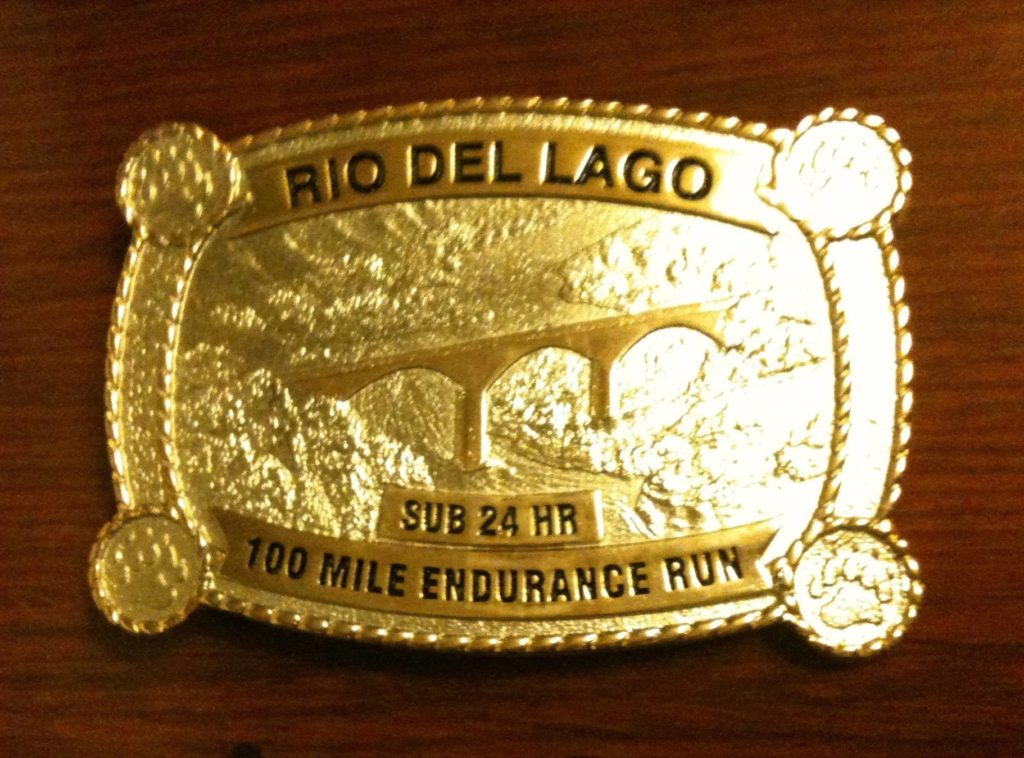
But when I saw the lights of the finish and the timing clock it felt good. After letting Joey go ahead I started running well toward the finish! 23:45 on the clock! I got my sub 24 buckle and a cup of soup. And I had to go in my car because I was becoming hypothermic fast despite the Mylar blanket they gave me. In the car, I cranked up the heat up and took off my contacts because they were dusty! Luckily I had taken the glasses from the drop bag. Then drove to the hotel, showered, put on compression tights and crashed! Mission accomplished!
RECOVERY
It was surprisingly fast. Right after I slept a couple of hours I went to the finish to walk a bit and although a bit stiff I wasn’t too sore, less than the day after Miwok or Pikes Peak. It was fun to chat with other runners and see the last finishers who after 32 or more hours on the trail are quite brave. I drove back to LA the day after a full day of rest and I could walk quite well. Even climbing stairs with no problems. Day after I went swimming. The next day I was running on trails in Griffith Park with no issue. I’m very surprised at ease of recover. I can perhaps attribute it to taking arnica montana before, during and after the race as well as applying Traumeel every tîme I would stop at Cool Aid Station.
CONCLUSION
I am very happy I have run this race. Although at first, I chose it because it seemed more attainable and giving me the assurance I would get my UTMB points it has been a great opportunity for growth and enrichment as an ultra runner. First I think that I have been able to refine my preparatory routines and mind management. I felt really rested at the start and with no anxiety (read Miwok race report to hear how bad pre-race conditions can be). I felt ready.
Secondly, I have grown in the execution of the race. Although getting lost really affected me for a while I managed to not let that beat me up too much. I also veered in the direction of not getting mad at the race organizer. I’m pretty happy with that too – anger toward not finding course markers dissipated. Better for me and better for them! I can’t say I “finished strong” like Miwok as after 105 or so miles I was getting tired. But I covered the distance in less than 24 hours which for a first 100 miler makes me very happy. Here some more photos:


